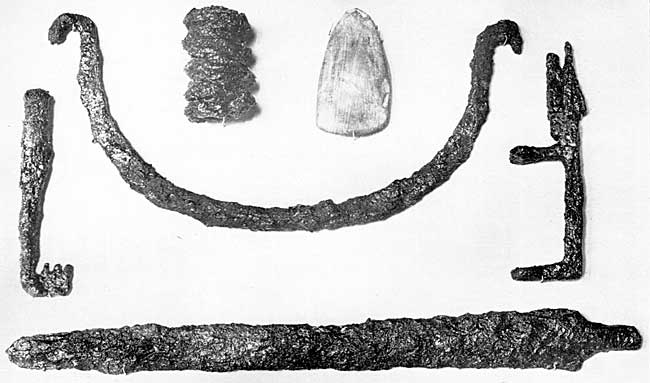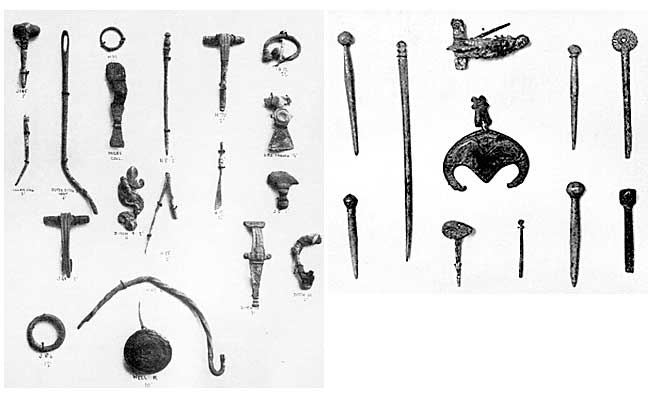Metal objects are, on the whole, not well preserved and are often much corroded; a gridiron of Flavian date is a somewhat rare object (Plate III.). Nails of all sizes are abundant, and the illustration (Plate XI.) shows a sword, a bucket handle, a key, a spring-lock, and a small greenstone axe, a relic of the Neolithic age, perhaps preserved as a talisman in Roman times.

PLATE XI. Iron sword, bucket handle, spring lock, etc., small greenstone axe.
Bronze objects are rather rare and consist mostly of brooches (fibulae) of various ages (Plate XII.). The dragonesque brooch with traces of enamel is worthy of mention since only about twenty are known ; it belongs to the early part of the Second Century. Other objects are a bronze packing-needle, a small scoop for ointment, a pair of tweezers, a pin, a pennanular brooch, a twisted handle of a box, etc. A gilt bronze horse-trapping (Plate XIII.), probably of late date is of interest; it is in the shape of a pelta or amazon's shield with eagle's heads, and a rude representation of a horse is incised on its surface. Bone pins and more rarely jet pins occur in the later period of occupation.

PLATE XII. Bronze fibulae, pins, etc. ——————— PLATE XIII. Bronze fibulae, pins, etc.

FIG. 1. Bronze pin.

FIG 2. Margidunum, Lincoln, Humby (Lincs).
An unusual bronze pin was found with its head in the form of an outstretched hand, very similar to the representation of the outstretched hand present on the top of the military standard of the Eighth Legion (Fig. 1).
An enamelled seal-box is of special importance, for it is an instance of a purely Roman object (intended to protect a seal of bees'-wax on correspondence), which has been decorated with a purely Celtic design. Enamelling in cloisonne reached a high degree of excellence in Britain in pre-Roman days, and this seal-box furnishes good evidence that the native arts were not (as some think) extinguished by the Roman conquest. This specimen was probably made locally, for the other examples of enamelled seal-boxes (Fig. 2) come from Lincolnshire and show very similar designs, so that it is very likely they were executed by the same artist.
Coins occur very sparingly, and I have only found one silver coin, a denarius probably issued by Vindex who led a revolt against Nero and supported the cause of Galba; an oak-wreath surrounding the letters S.P.Q.R. is on the reverse, whilst the place of the emperor's head is taken by a figure of Victory with the legend SALVS GENERIS HVMANI.
